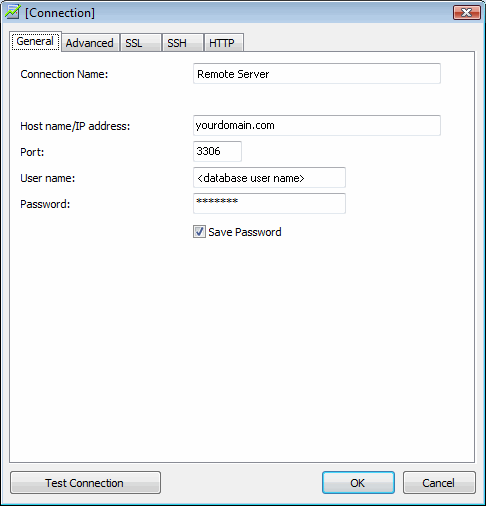This repo will tell you how Navicat encrypts password and offer a tool to reveal passwords encrypted by Navicat.
Navicat is a series of graphical database management and development software produced by PremiumSoft CyberTech Ltd. for MySQL, MariaDB, Oracle, SQLite, PostgreSQL and Microsoft SQL Server.
It has an Explorer-like graphical user interface and supports multiple database connections for local and remote databases. Its design is made to meet the needs of a variety of audiences, from database administrators and programmers to various businesses/companies that serve clients and share information with partners.
If you use Navicat to manage one of your databases, the first thing you should do is to create a connection to the database. So that means you should fill textboxes on the window showed below with the database's information like Host name, User name, Password and so on.
If you check "Save Password", after you click "Ok" button, Navicat will encrypt the password and then save the connection configuration, containing encrypted password, in Windows Registry. The exact path is showed below:
| Database Type | Path |
|---|---|
| MySQL | HKEY_CURRENT_USER\Software\PremiumSoft\Navicat\Servers\<your connection name> |
| MariaDB | HKEY_CURRENT_USER\Software\PremiumSoft\NavicatMARIADB\Servers\<your connection name> |
| MongoDB | HKEY_CURRENT_USER\Software\PremiumSoft\NavicatMONGODB\Servers\<your connection name> |
| Microsoft SQL | HKEY_CURRENT_USER\Software\PremiumSoft\NavicatMSSQL\Servers\<your connection name> |
| Oracle | HKEY_CURRENT_USER\Software\PremiumSoft\NavicatOra\Servers\<your connection name> |
| PostgreSQL | HKEY_CURRENT_USER\Software\PremiumSoft\NavicatPG\Servers\<your connection name> |
| SQLite | HKEY_CURRENT_USER\Software\PremiumSoft\NavicatSQLite\Servers\<your connection name> |
The following is an example:
See here.
-
Please make sure that you have
Python3. -
Please make sure that you have
pycryptodomemodule if you want to useNavicatCipher.pyandNcxReader.py.You can install
pycryptodomemodule by command:$ pip install pycryptodome -
Please make sure that you have
pypiwin32module if you want to useShowNavicat.py.You can install
pypiwin32module by command:$ pip install pypiwin32
-
NavicatCipher.py
Usage: NavicatCrypto.py <enc|dec> [-ncx] <plaintext|ciphertext> <enc|dec> "enc" for encryption, "dec" for decryption. This parameter must be specified. [-ncx] Indicate that plaintext/ciphertext is prepared for/exported from NCX file. This parameter is optional. <plaintext|ciphertext> Plaintext string or ciphertext string. NOTICE: Ciphertext string must be a hex string. This parameter must be specified.Example:
$ ./NavicatCipher.py enc "This is a test" 0EA71F51DD37BFB60CCBA219BE3A $ ./NavicatCipher.py dec 0EA71F51DD37BFB60CCBA219BE3A This is a test $ ./NavicatCipher.py enc -ncx "This is a test" B75D320B6211468D63EB3B67C9E85933 $ ./NavicatCipher.py dec -ncx B75D320B6211468D63EB3B67C9E85933 This is a test $ python3 Python 3.6.7 (default, Oct 22 2018, 11:32:17) [GCC 8.2.0] on linux Type "help", "copyright", "credits" or "license" for more information. >>> from NavicatCipher import * >>> cipher = Navicat12Crypto() >>> cipher.EncryptString('This is a test') '0EA71F51DD37BFB60CCBA219BE3A' >>> cipher.DecryptString('0EA71F51DD37BFB60CCBA219BE3A') 'This is a test' >>> cipher.EncryptStringForNCX('This is a test') 'B75D320B6211468D63EB3B67C9E85933' >>> cipher.DecryptStringForNCX('B75D320B6211468D63EB3B67C9E85933') 'This is a test'
-
NcxReader.py
Show database servers' information inside
*.ncxfile.Usage: NcxReader.py <Path to ncx file>Example:
$ ./NcxReader ~/connectioms.ncx -----------------xxxxxxxxxxxx-------------------- Connection Type = MYSQL Host = localhost Port = 3306 UserName = root Password = 12345678 ------------------yyyyyyyyyy--------------------- Connection Type = MYSQL Host = example.com Port = 3306 UserName = server Password = 0000000000 ... ... ...
-
ShowNavicat.py
Just run it in Windows. It will list all Navicat configurations inside Windows Registry.
Example:
>ShowNavicat.py +--------------------------------------------------+ | MySQL Server | +--------------------------------------------------+ Host: example.com Port: 3306 Username: server Password: 0000000000 ... ... +--------------------------------------------------+ | MariaDB Server | +--------------------------------------------------+ ... ... +--------------------------------------------------+ | MongoDB Server | +--------------------------------------------------+ ... ... ... ...
